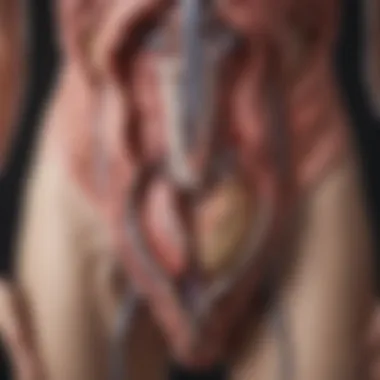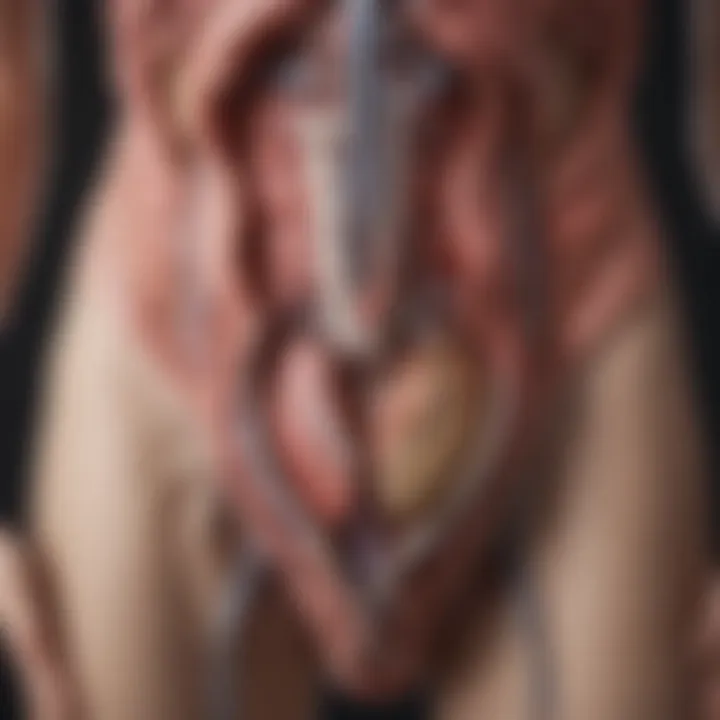Understanding UTI and Bladder Pressure Connection


Intro
Understanding the complexities surrounding urinary tract infections (UTIs) and bladder pressure is essential for both health professionals and the public. Many people encounter UTIs at least once in their lifetime. The symptoms can range from discomfort to severe complications. Bladder pressure is an important factor that contributes to this process, yet it remains a less discussed aspect in medical circles. This article aims to explore the intricate relationship between UTIs and bladder pressure.
The goal is to shed light on the physiological mechanisms at play, common symptoms associated with these conditions, and the various approaches to management and prevention. Considering the importance of this knowledge, the discussion will also emphasize the need for continued research and effective treatment strategies.
Key Findings
Major Results
The exploration reveals several key findings regarding UTIs and bladder pressure. UTIs are primarily caused by bacteria entering the urinary tract. Symptoms can vary from mild to severe and may include increased frequency of urination, burning sensations during urination, and heightened bladder pressure.
Research indicates that increased bladder pressure can exacerbate the discomfort caused by a UTI. Other findings show a correlation between persistent UTIs and prolonged elevated bladder pressure. This can lead to further complications such as bladder dysfunction or even kidney damage if left unmanaged.
Discussion of Findings
The findings highlight the multi-faceted nature of the relationship between UTIs and bladder pressure. Increased pressure can lead to inflammation of the bladder walls, making it more susceptible to infections. Conversely, the irritation caused by a UTI can lead to additional symptoms of pressure, creating a cyclical interaction between the two.
Understanding these dynamics is crucial. Knowledge of the symptoms associated with elevated bladder pressure can assist in early diagnosis and treatment, potentially preventing complications that may arise from neglected UTIs. Furthermore, this understanding opens discussions about holistic approaches to managing both conditions.
Methodology
Research Design
The research utilized both qualitative and quantitative methods. It involved reviewing existing literature on UTIs and bladder pressure, analyzing patient case studies, and conducting surveys among healthcare providers to gather insights on common practices related to diagnosis and treatment.
Data Collection Methods
Data collection involved multiple strategies, including:
- Literature Reviews: Academic papers, journals, and articles were reviewed to gather comprehensive information.
- Surveys: Questionnaires were distributed to health professionals to understand their perspectives on diagnosis and management.
- Case Studies: Real-life scenarios were examined to present varying experiences of individuals with UTIs and bladder pressure.
This thorough methodology ensures that our findings are well-supported and reflective of current practices and beliefs in the medical community.
"Understanding the intricate relationship between urinary tract infections and bladder pressure is essential for effective treatment and prevention strategies."
Prologue to Urinary Tract Infections
Urinary tract infections (UTIs) are a significant concern in both clinical and everyday settings. Understanding UTIs is essential due to their frequency, impact on health, and the relationship they have with bladder pressure. A deep exploration into this topic can shed light on how UTIs develop, their complications, and effective strategies for prevention and management. This section establishes a foundational comprehension that will aid professionals and students alike in addressing UTIs more effectively.
Defining UTIs
Urinary tract infections are infections that can occur anywhere in the urinary system, which includes the kidneys, ureters, bladder, and urethra. UTIs are most common in the lower urinary tract, affecting the bladder and urethra. The condition occurs when bacteria enter the urinary system, typically through the urethra, and multiply in the bladder. Symptoms often include a strong urge to urinate, burning sensation during urination, and cloudy or strong-smelling urine.
Recognizing the definition and characteristics of UTIs helps in understanding their broader implications, especially regarding bladder pressure. Early detection and treatment of UTIs can prevent complications, including recurrent infections and potential kidney damage.
Epidemiology of UTIs
The epidemiology of urinary tract infections provides insights into how prevalent they are across different demographics. Statistically, UTIs are one of the most common infections seen in clinical practice, particularly among women. Studies show that nearly 50-60% of women will experience a UTI at some point in their lives. Factors contributing to these statistics include anatomical differences, hormonal changes, and certain behaviors.
Men are less frequently affected, though UTIs in older men can be associated with urinary tract obstruction. Notably, certain populations, such as the elderly, pregnant women, and individuals with diabetes, have a higher risk of developing UTIs. Understanding these epidemiological trends is critical for implementing effective health interventions.
Common Pathogens Involved
Several pathogens are recognized as the primary culprits behind urinary tract infections. The vast majority of UTIs are caused by Escherichia coli, accounting for 80-90% of cases. Other bacteria such as Klebsiella, Proteus, Enterobacter, and Staphylococcus saprophyticus are also involved but to a lesser extent. The presence of these pathogens can lead to inflammation of the urinary tract, causing the associated symptoms.
Knowledge of these common pathogens is essential for healthcare professionals when tailoring treatment regimens. Culturing the urine helps identify specific species and susceptibility patterns of bacteria, which can guide further management. This relationship between pathogens and UTIs lays the groundwork for understanding how infections may influence bladder pressure.
Understanding Bladder Function
Understanding bladder function is critical to appreciate the broader implications of urinary tract infections (UTIs) and bladder pressure. The bladder serves as a storage reservoir for urine and plays a pivotal role in urinary elimination. Any disruption in its function can lead to a range of symptoms and complications.
The bladder is more than just a passive storage site; it actively manages the storage and release of urine. This suggests that maintaining healthy bladder function is essential not just for comfort but also for overall urinary health. Here, we will explore the anatomy and physiology of the bladder to gain insights into how it operates and how it relates to UTIs.
Anatomy of the Bladder
The bladder is a hollow muscular organ situated in the pelvis. Its capacity allows it to store urine until it is convenient to excrete. The main components of the bladder include:


- Detrusor Muscle: This smooth muscle layer surrounds the bladder. It contracts during urination, facilitating the expulsion of urine.
- Bladder Neck: At the junction where the bladder meets the urethra, this region controls the flow of urine. In men, it is also influenced by the prostate gland.
- Uroepithelial Layer: The inside lining of the bladder is a specialized tissue that can stretch when the bladder fills and has functional roles in signaling fullness.
Understanding these components is foundational for analyzing how conditions, such as UTIs, influence bladder pressure and function. Dysfunctional anatomy can lead to incomplete emptying or increased urgency, further complicating infection management.
Physiology of Bladder Storage and Emptying
The physiology of bladder storage and emptying comprises intricate processes that rely on nervous system signals and muscular contractions.
- Storage Phase: During this phase, the detrusor muscle remains relaxed while the bladder fills with urine. This is regulated by the sympathetic nervous system, which keeps the bladder distensible without causing discomfort.
- Emptying Phase: When the bladder reaches its capacity, stretch receptors signal the brain, leading to the urge to urinate. The detrusor muscle contracts, while the internal and external sphincters relax under voluntary control. This process ensures that urine is expelled at the appropriate time and in a controlled manner.
The relationship between the bladder’s physiology and UTI symptoms is significant. For example, during a UTI, the bladder’s wall can become inflamed, leading to increased pressure. This inflamed state causes frequent urges and discomfort, impacting daily life.
"Understanding the balance between storage and emptying helps elucidate why UTIs can lead to significant quality of life issues."
In summary, the bladder's anatomy and physiology are essential in understanding the interplay between UTIs and bladder pressure. This overview sets the groundwork for further inquiry into how infections disrupt normal function, leading to urgent health considerations.
The Relationship Between UTIs and Bladder Pressure
Understanding the relationship between urinary tract infections (UTIs) and bladder pressure is essential for comprehending the full impact UTIs have on health. UTIs can lead to several physiological and psychological complications that might not be immediately obvious. Bladder pressure is especially crucial since it relates to how well the bladder functions in urine storage and release. This linkage can inform clinicians about the more nuanced symptoms and assist in developing targeted interventions.
Factors such as inflammation and irritability of the bladder wall during a UTI can lead to increased pressure. This pressure can affect bladder capacity and the ability to void effectively. Recognizing these dynamics not only aids in managing current infections but also helps in preventing recurrent episodes.
How UTIs Affect Bladder Pressure
UTIs typically arise from the introduction of bacteria into the urinary tract, leading to inflammation. This inflammation can contribute significantly to increased bladder pressure. The bladder serves as a reservoir for urine, and when certain pathogens invade this area, it becomes inflamed.
Increased inflammation can reduce the bladder's ability to stretch and can lead to dysfunction in normal emptying mechanisms. As a result, individuals may experience a heightened urge to urinate despite the bladder not being fully filled. This condition often leads to a class of symptoms known as bladder overactivity, which can be distressing and affect daily life.
Moreover, the pressure generated can sometimes lead to urinary retention, which is the inability to fully empty the bladder. Some patients may report a sensation of urgency but struggle to urinate, creating a paradox where they feel the need to go continuously. This interplay between infection and bladder pressure is vital for assessing patient symptoms.
Changes in Sensation and Urgency
Patients with UTIs often report alterations in urinary sensation. These are characterized by a sudden and frequent need to urinate, commonly referred to as urgency. This sense of urgency arises as the body's response to the infection, situating it within a broader framework of discomfort.
The interplay between urgency and pressure is complex. Intact nerves in the bladder wall send signals to the brain about bladder fullness and pressure. During a UTI, these signals can become exaggerated. Consequently, the neurological pathways that control bladder sensation often respond by amplifying the urgency perceived by the individual.
In many cases, this leads to a condition where there is minimal urine output with volatile levels of urgency, which may cause anxiety. It is vital for clinicians to understand these sensations as they point to the underlying bladder dysfunction, which can persist even after a UTI is resolved. Thus, effective management strategies should consider not only treating the infection but also addressing the resultant changes in bladder pressure and sensation.
In summary, understanding how UTIs influence bladder pressure and sensations can significantly aid healthcare providers in diagnosis, management, and patient education.
Symptoms Associated with UTI and Bladder Pressure
Understanding the symptoms associated with urinary tract infections (UTIs) and bladder pressure is crucial for appropriate recognition and timely treatment. These symptoms can significantly impact quality of life and can indicate various underlying issues. Symptoms often serve as the first line of indication prompting an individual to seek medical help. Awareness of these signs is essential for healthcare professionals and patients alike, as they can aid in differentiating between a simple UTI and more complex bladder issues.
Key Considerations:
- Proper management hinges on the accurate identification of symptoms.
- Early detection can prevent complications such as recurrent infections.
- Distinguishing UTI symptoms from other bladder pressures is necessary for correct treatment approaches.
Understanding these symptoms not only aids in immediate medical intervention but also informs future preventive strategies.
Common Symptoms of UTI
Common symptoms of a urinary tract infection often include:
- Dysuria: Painful or burning sensations during urination.
- Increased frequency: A frequent urge to urinate, even if little urine is produced.
- Urgency: A sudden, compelling need to urinate.
- Cloudy urine: Urine that appears cloudy or has a strong odor.
- Pelvic pain: Discomfort or pressure in the lower abdomen or back.
These symptoms often arise due to inflammation caused by the infection. Patients may feel these symptoms abruptly, which can cause distress. Notably, elderly patients or those with certain health conditions may exhibit atypical symptoms, making reporting critical for accurate diagnosis.
Physical Manifestations of Increased Bladder Pressure
Increased bladder pressure can manifest through various physical symptoms that may overlap with UTI symptoms. These manifestations may include:
- Increased urgency: The feeling of needing to urinate more frequently and suddenly.
- Incontinence: An involuntary loss of urine due to pressure.
- Discomfort or pain: Individuals may experience pressure in the lower abdomen when their bladder is distended.
- Difficulty starting urination: A feeling of blockage or hesitation when attempting to urinate.
These symptoms can be indicative of bladder dysfunction, which requires further assessment. It is essential to recognize these manifestations as they may indicate complications arising from untreated UTIs, such as bladder overactivity or retention. Furthermore, untreated conditions can lead to chronic issues that affect overall bladder health.
Diagnosis of UTIs and Assessment of Bladder Pressure
Diagnosing urinary tract infections (UTIs) and assessing bladder pressure are crucial steps in managing these conditions. Accurate diagnosis leads to appropriate treatment, which can prevent complications. Understanding the assessment processes can aid clinicians in identifying underlying issues effectively. This section emphasizes the methodology behind diagnosis and assessment, including clinical evaluations, history-taking, laboratory tests, and imaging techniques.


Clinical Evaluation and History-Taking
A comprehensive clinical evaluation is vital for diagnosing UTIs and understanding bladder pressure dynamics. The clinician begins with an in-depth history-taking process. This process helps gather essential information about the patient's symptoms, medical history, and urinary habits.
Key elements during this evaluation include:
- Symptom Description: Patients should describe their symptoms accurately, including the onset, duration, and severity. Common symptoms like dysuria, frequency, and urgency are critical indicators.
- Medical History: Previous UTIs, any ongoing conditions like diabetes, and a history of urinary or gynecological surgeries can influence diagnosis.
- Medication Review: Current medications can provide insight into potential side effects that may affect bladder function or increase the likelihood of UTIs.
During the physical examination, clinicians often assess tenderness in the lower abdomen and perform a pelvic exam in women to rule out additional infections.
Laboratory Tests and Imaging Techniques
Laboratory tests play a significant role in confirming UTI diagnoses and assessing bladder pressure. The most common initial test is a urinalysis. This test checks for:
- Presence of Leukocytes: Indicates infection.
- Nitrites: Suggests the presence of bacteria.
- Hematuria: The presence of blood can indicate a more serious condition.
Cultures are also essential. When a urinalysis suggests an infection, a urine culture quantifies the bacteria and identifies the specific pathogens involved. This helps tailor antibiotic treatment to the individual’s needs.
In some cases, imaging techniques may also be employed. Techniques such as Ultrasound or CT scans examine the urinary tract’s anatomical structure and identify any abnormalities.
Furthermore, urodynamic testing is important for assessing bladder pressure. This test evaluates bladder function and pressure during filling and voiding. It provides insights into urinary incontinence issues that may stem from abnormal bladder pressure or dysfunction.
"Accurate diagnosis not only ensures appropriate therapy but also enhances patient comfort and expedites recovery."
Finally, integrating findings from these evaluations leads to a comprehensive understanding of the patient’s condition. This approach allows the medical professional to create a tailored management plan that effectively addresses both UTI and bladder pressure concerns.
Management Strategies for UTIs and Bladder Pressure
Effective management strategies for urinary tract infections (UTIs) and bladder pressure are crucial for improving patient outcomes and enhancing overall bladder health. This section will delve into pharmacological interventions as well as non-pharmacological approaches. Understanding both categories is essential for a multi-faceted approach to treatment, considering possible complications and patient preferences.
Pharmacological Interventions
Pharmacological interventions are often the first line of defense against UTIs. Antibiotics play a pivotal role in treating bacterial infections. The choice of antibiotic depends on the patient’s medical history and specific bacteria involved. Some commonly prescribed antibiotics include Trimethoprim/Sulfamethoxazole, Nitrofurantoin, and Ciprofloxacin. It is essential that health professionals select the right medication to minimize resistance and maximize efficacy.
In addition to antibiotics, other medications can help to manage bladder pressure. For instance, antispasmodics may be useful to alleviate bladder spasms, which can occur during a UTI. Moreover, analgesics can provide relief from pain associated with bladder pressure. Reducing bladder wall irritation may also lessen urgency and discomfort.
It is important to note that the use of pharmacological treatments must be closely monitored. Potential side effects can include gastrointestinal disturbances or adverse reactions to the medications. Consequently, regular follow-ups and assessments should be scheduled to ensure patient safety and medication effectiveness.
Non-Pharmacological Approaches
Non-pharmacological approaches offer additional support and can be incorporated alongside medication to enhance therapy. One effective strategy involves hydration. Drinking plenty of fluids helps flush bacteria from the urinary tract, reducing the chance of infection. Cranberry juice is often touted for its potential in preventing UTIs, although scientific evidence remains mixed. Nevertheless, hydration is universally acknowledged as a primary preventive measure.
Another approach involves behavior modification, such as timed voiding or scheduled bathroom visits. This can help manage pressure in the bladder and train the body to create regular urination habits, potentially leading to fewer episodes of urgency and incontinence.
Pelvic floor exercises, such as Kegel exercises, strengthen the pelvic muscles and support bladder control. These exercises can be advantageous for individuals suffering from increased bladder pressure or post-UTI complications. Education on proper techniques is crucial for efficacy.
"Patient education on lifestyle choices and behavioral adjustments is as vital as pharmacological treatment for managing bladder health."
Both pharmacological and non-pharmacological methods present avenues for managing UTIs and bladder pressure effectively. The integration of these strategies caters to individual needs and may lead to significant improvements in patient quality of life. Clinicians should remain informed on the latest practices and innovations to offer personalized treatment plans, thus empowering patients in their health journeys.
Potential Complications of UTIs
Understanding the potential complications of urinary tract infections (UTIs) is vital for addressing both immediate and long-term health issues. UTIs can lead to various complications that may significantly affect an individual’s bladder health and overall quality of life. Knowing these complications allows for better prevention strategies and treatment options.
Recurrent UTIs and Bladder Dysfunction
Recurrent urinary tract infections are a common complication. Women tend to experience these more frequently than men. A recurrent UTI can be defined as having two or more infections within six months or three or more within a year. Frequent infections can lead to bladder dysfunction. This may present as a weakened bladder or increased bladder pressure. Chronic bladder irritation from recurrent infections may also lead to inflammation and other complications.
Several factors contribute to the recurrence of UTIs. Inadequate antibiotic treatment or improper hygiene practices can lead to reinfection. Furthermore, structural problems in the urinary tract can increase susceptibility to UTIs. Women with a history of UTIs often report symptoms of urgency and frequency even in the absence of infection, suggesting a link between recurrent infections and ongoing bladder issues. It is essential to address this cycle, as the implications extend beyond mere discomfort.
Long-Term Effects on Bladder Health
The long-term effects of untreated or poorly managed UTIs are a serious concern. Persistent infections can lead to chronic changes in the bladder lining, potentially causing long-lasting sensitivity and pain. Over time, this inflammation can lead to dysfunction. Individuals might experience constant pressure in the bladder with frequent urges, which can impair daily activities.
Additionally, ongoing UTIs may increase the risk of kidney infections or pyelonephritis, which affects kidney function and overall health. Long-lasting infections can lead to severe complications such as sepsis, a life-threatening systemic infection. Thus, early treatment and management of UTIs are critical to avoid detrimental long-term effects.
"Addressing UTIs promptly can help prevent complications that might otherwise persist and escalate into chronic health issues."


To reduce the risk of complications, it is recommended to maintain proper hydration, avoid irritants, and practice good hygiene. Patients experiencing recurrent UTIs should work closely with healthcare professionals to explore all potential underlying causes. Understanding the relationship between UTIs and bladder health serves as a foundation for effective prevention and therapeutic strategies.
Prevention of UTIs and Maintaining Healthy Bladder Pressure
Preventing urinary tract infections (UTIs) and maintaining healthy bladder pressure are crucial components of urological health. UTIs can lead to significant complications, including recurrent infections and bladder dysfunction. Understanding prevention strategies ensures that individuals can actively reduce their risk and promote better bladder function.
Healthy bladder pressure implies that the bladder can store urine without discomfort and can empty completely when required. When pressure in the bladder is too high, it can lead to urinary urgency, incontinence, or other complications. Thus, a dual approach involving lifestyle modifications and hygiene practices is essential.
Lifestyle Modifications
Making specific lifestyle changes can significantly decrease the likelihood of developing UTIs. Here are some important modifications to consider:
- Hydration: Drinking ample amounts of water helps flush the urinary system. It dilutes urine and encourages frequent urination, which can expel bacteria before they establish an infection.
- Cranberry Products: Some studies suggest that cranberry juice may reduce the risk of UTIs by preventing bacteria from adhering to the urinary tract lining. However, results may vary from person to person.
- Dietary Choices: Incorporating probiotics, particularly those found in yogurt, may support urinary tract health. Avoiding irritants, such as caffeine and spicy foods, can also prevent bladder pressure fluctuations.
- Regular Exercise: Engaging in physical activity can enhance overall health. Exercise helps maintain a healthy weight and can reduce pressure on the bladder.
- Timed Voiding: This practice involves scheduling bathroom visits at regular intervals, avoiding the prolonging of bladder fullness, which can lead to increased pressure and potential infections.
Maintaining an awareness of these lifestyle practices leads to better management of bladder health and reduces UTI risks.
Hygiene Practices
Proper hygiene is equally important in preventing UTIs. Here are some practices that can be helpful:
- Wiping Technique: After using the toilet, always wipe from front to back. This reduces the risk of bacteria from the anal region entering the urethra.
- Urination After Intercourse: It is advisable to urinate soon after sexual activity. This can help flush out any bacteria that may have entered the urethra during intercourse.
- Appropriate Clothing: Wearing loose-fitting clothing and cotton underwear can help maintain dryness. Avoiding overly tight clothes that retain moisture can keep the area dry and reduce bacterial growth.
- Avoiding Scented Products: Refrain from using scented soaps or feminine hygiene products in the genital area, as they can irritate the urethra and potentially cause infections.
- Regular Bathing: Maintaining good general hygiene through regular baths or showers can keep bacteria levels low.
Adopting these hygiene practices is vital for anyone looking to minimize their risk of UTIs and keep their bladder functioning optimally.
"Prevention is always better than cure. Taking small steps in daily life can go a long way in maintaining urinary health."
By implementing these lifestyle modifications and hygiene practices, individuals can effectively reduce the risk of UTIs and promote healthy bladder pressure. Emphasizing prevention is key to enhancing quality of life and ensuring urological health.
Recent Research and Innovations
The exploration of urinary tract infections (UTIs) and bladder pressure has seen significant advancements in recent years. The focus of this section is twofold: to highlight emerging treatments for UTIs and to investigate new techniques for managing bladder pressure. These areas not only enhance our understanding of the subject but also lead to better patient outcomes.
Emerging Treatments for UTIs
Recent studies emphasize the necessity for innovative treatments in combating UTIs. Traditional antibiotics, while effective to an extent, often face challenges. The prevalence of antibiotic resistance poses a serious threat to treatment efficacy. In response to this, researchers have been investigating alternative therapies. Some of the promising options include:
- Phage Therapy: This approach utilizes bacteriophages, viruses that specifically target and kill bacteria. Phage therapy could present an effective strategy for treating antibiotic-resistant infections.
- Vaccination: There are ongoing clinical trials for vaccines aimed at preventing UTIs. A successful vaccine could significantly reduce the incidence of these infections.
- Biofilm Disruption: Research is increasingly looking into methods that disrupt biofilms formed by bacteria in the urinary tract. Innovations in enzymatic treatments show potential to enhance treatment and prevent recurrences.
The development of these treatments evidences a shift towards more targeted and sustainable approaches. They expand therapeutic options available to patients, paving the way for personalized treatment plans.
Investigating Bladder Pressure Management Techniques
Managing bladder pressure effectively is crucial, particularly for those suffering from chronic UTIs or bladder dysfunction. Several innovative techniques are emerging. These techniques are essential for improving quality of life for patients and minimizing complications. Some of the key areas of focus include:
- Neuromodulation: This technique involves electrical stimulation of nerves to improve bladder function. It has shown promise in reestablishing normal patterns of bladder contraction and urine storage.
- Behavioral Therapies: Techniques such as bladder training and pelvic floor exercises have gained attention. Studies support their effectiveness in enhancing bladder control and reducing urgency.
- Biomaterials in catheterization: Recent advancements in material science have led to the development of catheters that reduce trauma and inflammation in the bladder. These innovations aim to improve functionality and patient comfort.
Research in these areas contributes profoundly to our understanding of bladder pressure management. The advancements offer hope for more effective interventions and better overall care for individuals affected by UTIs and bladder-related issues.
"In the context of UTIs and bladder health, keeping abreast of recent research is vital."
Integrating new knowledge into practice will ensure healthcare professionals can provide optimal care and remain ahead of emerging challenges.
Epilogue
The conclusion of this article serves as a pivotal reflection on the intricate relationship between urinary tract infections (UTIs) and bladder pressure. Understanding these connections is essential for medical professionals, scholars, and those interested in bladder health. This is not merely an academic exercise; it has significant implications for improving patient outcomes and guiding future research.
The ability to recognize how UTIs influence bladder pressure can lead to more effective management strategies. It can help clinicians develop tailored interventions that directly address symptoms and complications arising from these infections. Furthermore, understanding the physiological mechanisms at play invites a closer examination of how lifestyle choices can mitigate risks associated with both UTIs and heightened bladder pressure.
Summary of Key Insights
Several key insights surface from our exploration of UTIs and bladder pressure. First, UTIs are prevalent conditions that can substantially affect bladder function. They often lead to increased urgency and discomfort, directly affecting patient quality of life. Understanding the symptoms that arise with UTIs can facilitate early diagnosis and treatment.
The relationship between UTIs and bladder pressure is multifaceted. Increased bladder pressure can exacerbate the symptoms of a UTI, while a UTI can disrupt normal bladder function, creating a feedback loop that complicates recovery.
Additionally, the impact of recurrent UTIs on bladder dysfunction cannot be overstated. They may lead to long-term alterations in bladder health, making it critical for healthcare providers to consider preventive measures as part of a comprehensive management strategy.
Future Directions in Research
Looking ahead, there are multiple avenues for future research that could broaden our understanding of UTIs and bladder pressure. Studies investigating the underlying mechanisms of how UTIs affect bladder sensitivity and control might lead to innovative treatment protocols.
Moreover, exploring new pharmacological and non-pharmacological interventions that target both UTIs and bladder pressure may provide enhanced patient care. Research into patient education on lifestyle modifications can be particularly beneficial, as it empowers individuals to take an active role in managing their health.
There is also potential for investigating the relationship between UTIs and other comorbid conditions. This could unearth connections that inform better holistic approaches in treatment.
In summary, the ongoing investigation into the complex interplay of UTIs and bladder pressure is crucial. Continued efforts in this field can ultimately lead to improved therapeutic options and enhanced quality of life for those affected by these conditions.



